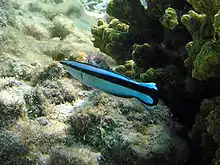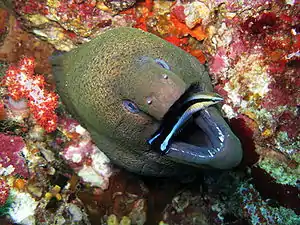Bluestreak cleaner wrasse
The bluestreak cleaner wrasse, Labroides dimidiatus, is one of several species of cleaner wrasses found on coral reefs from Eastern Africa and the Red Sea to French Polynesia. Like other cleaner wrasses, it eats parasites and dead tissue off larger fishes' skin in a mutualistic relationship that provides food and protection for the wrasse, and considerable health benefits for the other fishes.[3][4][5]
| Bluestreak cleaner wrasse | |
|---|---|
 | |
| Scientific classification | |
| Kingdom: | Animalia |
| Phylum: | Chordata |
| Class: | Actinopterygii |
| Order: | Labriformes |
| Family: | Labridae |
| Genus: | Labroides |
| Species: | L. dimidiatus |
| Binomial name | |
| Labroides dimidiatus (Valenciennes, 1839) | |
| Synonyms[2] | |
| |
Description
This is a small wrasse, averaging 10 cm long (14 cm max). It can be recognized thanks to a wide longitudinal black stripe running along the side and eye; the back and the stomach are white (sometimes slightly yellowish). This white part changes to a bright blue on the front of the animal, while the black band widens at the tail. The young are black with an electric blue line.
A genetic analysis of L. dimidiatus revealed the population fell into two monophyletic clades, with Indian Ocean populations generally having different stripe widths to western Pacific fishes. The Japanese cleaner wrasses, though, fell within the same group as Indian Ocean fish, despite differing in appearance, and both clades overlap around Papua New Guinea.[5] Two closely related cleaner wrasse species, Labroides pectoralis and Labroides bicolor, were grouped inside the L. dimidiatus clade, so the bluestreak cleaner wrasse may in fact be polyphyletic, incorporating several species.[5]
Distribution
The bluestreak cleaner wrasse is found on coral reefs in the tropics from the Red Sea and Indian Ocean to the western Pacific (including Papua New Guinea, Japan, Fiji, and French Polynesia).[5] It was first recorded from the Kermadec Islands Marine Reserve north of New Zealand in 2015, after researchers examined hundreds of hours of unused documentary film footage.[6][7]
Cleaning

Cleaner wrasses are usually found at cleaning stations. Cleaning stations are occupied by different units of cleaner wrasses, such as a group of youths, a pair of adults, or a group of females accompanied by a dominant male. When visitors come near the cleaning stations, the cleaner wrasses greet the visitors by performing a dance-like motion in which they move their rear up and down.[8] The visitors are referred to as "clients". Bluestreak cleaner wrasses clean to consume ectoparasites on client fish for food. The bigger fish recognise them as cleaner fish because they have a lateral stripe along the length of their bodies,[9] and by their movement patterns. Cleaner wrasses greet visitors in an effort to secure the food source and cleaning opportunity with the client. Upon recognising the cleaner and successfully soliciting its attention, the client fish adopts a species-specific pose to allow the cleaner access to its body surface, gills and sometimes mouth. Other fish that engage in such cleaning behavior include goby fish (Elacatinus spp.)[10]
 L. dimidiatus with a client surgeonfish at a cleaning station.
L. dimidiatus with a client surgeonfish at a cleaning station. Cleaner Wrasse with a client Moray eel
Cleaner Wrasse with a client Moray eel

Some fish mimic cleaner wrasses. For example, a species of blenny called Aspidontus taeniatus has evolved the same behavior to tear small pieces of flesh or skin from bigger fish rather than rid them of parasites. Another species, the bluestreak fangblenny, Plagiotremus rhinorhynchos, mimics juvenile cleaner wrasse so its presence is tolerated by the cleaners, which, it is assumed, enables it to take advantage of the concentration of potential victims.[11]
References
- Shea, S. & Liu, M. (2010). "Labroides dimidiatus". IUCN Red List of Threatened Species. 2010: e.T187396A8523800. doi:10.2305/IUCN.UK.2010-4.RLTS.T187396A8523800.en. Retrieved 13 January 2020.
- Eschmeyer, William N.; Fricke, Ron & van der Laan, Richard (eds.). Labroides "Species in the genus 'Labroides'". Catalog of Fishes. California Academy of Sciences. Retrieved 13 January 2020.
- Côté, I.M. (2000). "Evolution and ecology of cleaning symbioses in the sea". Oceanography and Marine Biology: An Annual Review. 38 (1): 311–355.
- Johnson, M.L. (2012). "High street cleaners". Biodiversity Science.
- Sims, C.A.; Riginos, C.; Blomberg, S.P.; Huelsken, T.; Drew, J.; Grutter, A.S. (2013). "Cleaning up the biogeography of Labroides dimidiatus using phylogenetics and morphometrics". Coral Reefs. 33: 223–233. doi:10.1007/s00338-013-1093-2.
- Liggins, Libby; Sweatman, Jenny Ann; Trnski, Thomas; Duffy, Clinton A. J.; Eddy, Tyler D.; Aguirre, J. David (2020). "Natural history footage provides new reef fish biodiversity information for a pristine but rarely visited archipelago". Scientific Reports. 10 (1): 1–7. doi:10.1038/s41598-020-60136-w.
- Hancock, Farah (16 March 2020). "New species accidentally discovered on film". Newsroom. Retrieved 2020-03-16.
- Froese, Ranier. "Labroides dimidiatus". FishBase. Retrieved 16 September 2013.
- Stummer, L.E.; Weller, J.A.; Johnson, M.L. & Côté, I.M. (2005). "Size and stripes: how clients recognise cleaners". Animal Behaviour. 68 (1): 145–150. doi:10.1016/j.anbehav.2003.10.018.
- M.C. Soares; I.M. Côté; S.C. Cardoso & R.Bshary (August 2008). "The cleaning goby mutualism: a system without punishment, partner switching or tactile stimulation" (PDF). Journal of Zoology. 276 (3): 306–312. doi:10.1111/j.1469-7998.2008.00489.x.
- Johnson, Magnus & Hull, Susan (2006). "Interactions between fangblennies (Plagiotremus rhinorhynchos) and their potential victims: fooling the model rather than the client?". Marine Biology. 148 (1): 889–897. doi:10.1007/s00227-005-0118-y.
Further reading
- Meulengracht-Madsen, Jens: (1976) Akvariefisk i farger, J.W. Cappelens forlag AS
- Labroides dimidiatus at FishBase
External links
 Data related to Labroides dimidiatus at Wikispecies
Data related to Labroides dimidiatus at Wikispecies Media related to Labroides dimidiatus at Wikimedia Commons
Media related to Labroides dimidiatus at Wikimedia Commons- Photos of Bluestreak cleaner wrasse on Sealife Collection




